Solar Simulator Market Research, 2031
The global solar simulator market size was valued at $203.6 million in 2021, and is projected to reach $364.6 million by 2031, growing at a CAGR of 5.8% from 2022 to 2031. Solar simulator (sometimes known as an artificial sun) is a device that simulates natural sunlight. The solar simulator is used to create a regulated indoor test facility that can be used to evaluate solar cells, sunscreen, polymers, and other materials and devices under laboratory settings. Solar simulator is made up of three main parts: a light source, accompanying power supply optics, and filters that change the output beam to match classification requirements.
Lockdown imposed due to the outbreak of COVID-19 pandemic resulted in temporary ban on import & export and manufacturing & processing activities across various industries, which decreased the demand for testing components from industries including solar, healthcare, automotive, chemicals, and others. In addition, halt in building and construction of solar energy power plants, owing to unavailability of workers and increase in demand–supply gap hampered the solar simulator market growth during the pandemic period. This declined the market growth in second, third, and fourth quarters of 2020. However, the solar simulator market recovered by the 2nd quarter of 2021, as COVID-19 vaccination began in various economies across the globe, which improved the global economy.
The growth of the global solar simulator market is driven by rise in demand for solar simulators from R&D applications. In addition, rise in demand for UV protection testing devices such as solar simulators from industries including healthcare, pharmaceutical, environmental science and others, are anticipated to fuel the growth of the solar simulator market from 2022 to 2031. However, high cost and disadvantages associated with solar simulators are expected to hamper the solar simulator market growth in the coming years. On the contrary, increased government support for R&D aimed at improving the efficiency of solar energy products for consumers is expected to create new opportunities for solar simulator market growth during the forecast period.
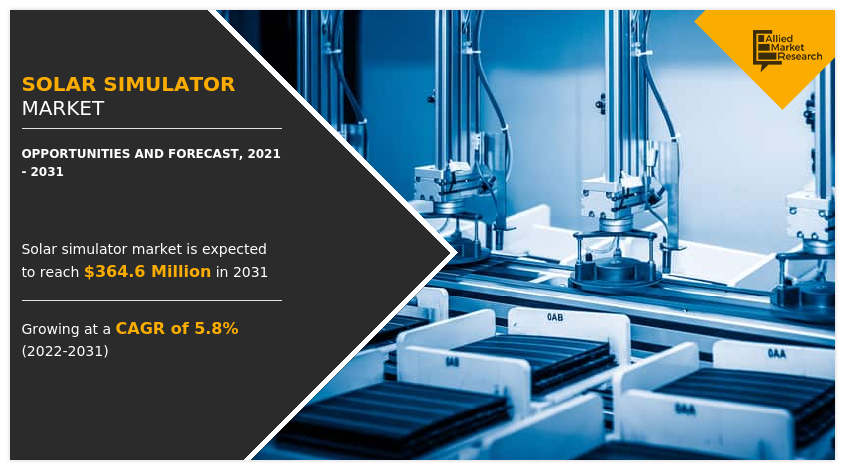
The solar simulator market is segmented into type, light source and application. The report highlights information about various types of solar simulators including steady state and pulsed. By light source, the solar simulator market is fragmented into xenon arc lamp, metal halide arc lamp, UV lamp, QTH lamp, and LED lamp. In addition, the applications covered in the study include PV cell/module and material testing, UV testing of materials and products, automotive testing, biomass study, and others. It further emphasizes on region wise revenue garnered across North America, Europe, Asia-Pacific, and LAMEA.
The global market covers in-depth information about the major solar simulator industry participants. Some of the major players in the market include ABB, Ltd., ABET Technologies, Inc., Asahi Spectra Co., Ltd., Endeas, Gsolar Power Co., Ltd., Iwasaki Electric Co., Ltd., Sciencetech, Inc., Schneider Electric, Solar Light Company, LLC, and Spectrolab.
Other players operating in the value chain of the global solar simulator market are OAI, Wacom Electric Co. Ltd., Nisshinbo Mechatronics, Inc., Spire Solar, and others.
The key players have adopted numerous strategies such as product launch, acquisition, agreement, partnership, and business expansion, to stay competitive in the solar simulator market.
For instance, in January 2022, Abet Technologies, Inc. launched a new product line of Sunlite solar simulators, which are easily converted to a horizontal or up-pointing beam configuration using only a screwdriver. The standard system is delivered with one 100-watt Xenon arc lamp, an AM1.5G air mass filter, an adjustable height stand, and HEPA filtered cooling air. This has strengthened the product portfolio of the company in this market.
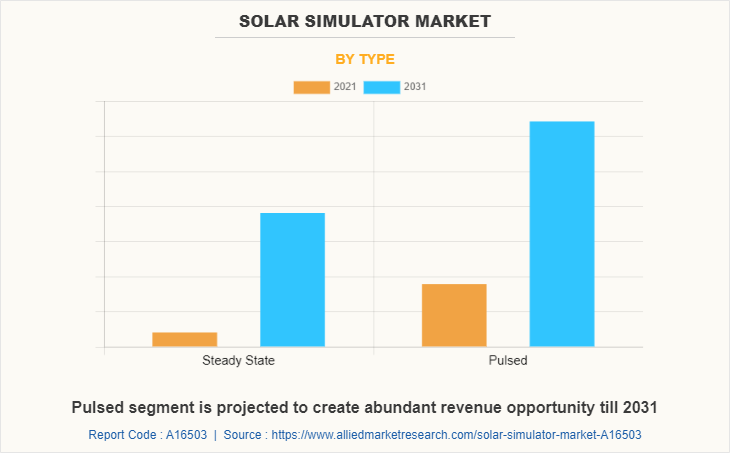
Depending on type, the pulsed segment held the highest solar simulator market share of around 56.7% in 2020, and is expected to maintain its dominance during the forecast period. This is attributed to rise in demand for pulsed solar simulators from PV module testing and other applications. In addition, increase in demand for rapid & accurate measurement of electrical power output, characteristics of PV cells, modules, and solar panels for manufacturing of standard products is further expected to fuel the growth of the market in the coming years.
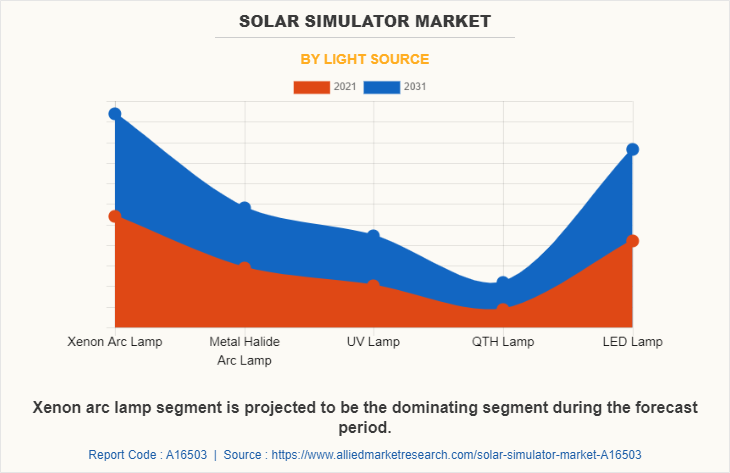
On the basis of light source, the xenon arc lamp segment holds the largest share, in terms of revenue, and is expected to maintain its dominance during the solar simulator market forecast period. This growth is attributed to rise in demand for xenon arc lamp based solar simulator owing to its ability to produce stable spectral equal to the sunlight without filtering from various applications including testing of PV cell or module applications. In addition, increase in use of xenon arc lamp based solar simulator owing to advantages associated with it such as good match to sunlight spectrum, stable spectrum, ability to produce high intensity beams and others, is expected to fuel the growth of the xenon arc lamp based solar simulator market in the coming years.
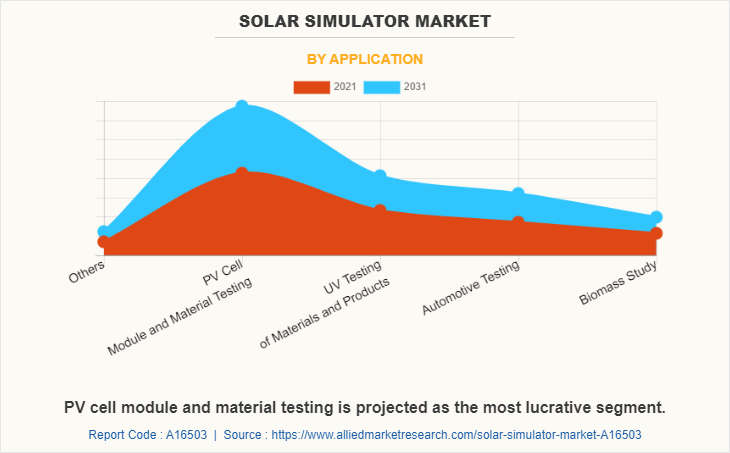
On the basis of application, the PV cell/module and material testing segment holds the largest share, in terms of revenue, and is expected to maintain its dominance during the forecast period. This growth is attributed to rapid growth in the solar energy industry over the last decade, which is projected to continue in the upcoming years and owing to increased investments in renewable energy across the globe. In addition, rise in demand for solar panels to energize home appliances such as lights and pumps, boosts the demand for solar based products, which in turn is expected to drive the growth of the solar simulator for the testing of modules and PV materials during the forecast period.
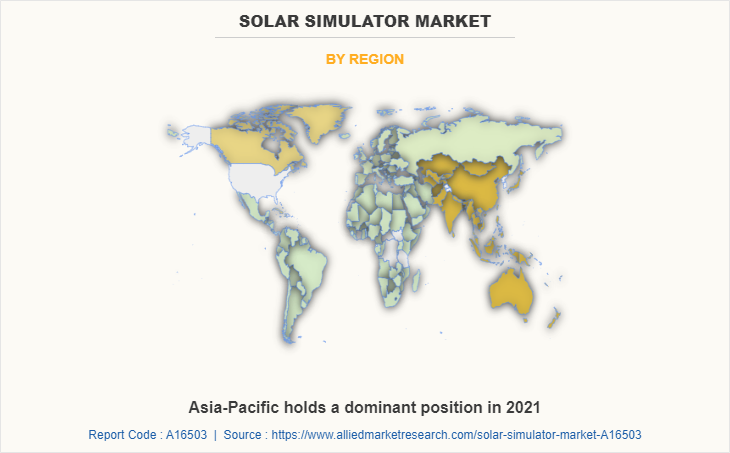
On the basis of region, the market is analyzed across four major regions such as North America, Europe, Asia-Pacific, and LAMEA. Asia-Pacific garnered the dominant share in 2020, and is anticipated to maintain this dominance in the solar simulator market trend during the forecast period. This is attributed to the presence of key players and huge consumer base in the region.
In addition, rapid expansion of the renewable energy sector, rise in investment toward building & construction of renewable energy infrastructure, and increase R&D efforts in the region are further anticipated to fuel the growth of the market in the upcoming years.
The solar simulator market is analyzed and estimated in accordance with the impacts of the drivers, restraints, and opportunities. The period studied in this report is 2021–2031. The report includes the study of the solar simulator market with respect to the growth prospects and restraints based on regional analysis. The study includes Porter’s five forces analysis of the industry to determine the impact of suppliers, competitors, new entrants, substitutes, and buyers on the market growth.
Key Benefits For Stakeholders
- This report provides a quantitative analysis of the market segments, current trends, estimations, and dynamics of the solar simulator market analysis from 2021 to 2031 to identify the prevailing solar simulator market opportunities.
- The market research is offered along with information related to key drivers, restraints, and opportunities.
- Porter's five forces analysis highlights the potency of buyers and suppliers to enable stakeholders make profit-oriented business decisions and strengthen their supplier-buyer network.
- In-depth analysis of the solar simulator market segmentation assists to determine the prevailing market opportunities.
- Major countries in each region are mapped according to their revenue contribution to the global market.
- Market player positioning facilitates benchmarking and provides a clear understanding of the present position of the market players.
- The report includes the analysis of the regional as well as global solar simulator market trends, key players, market segments, application areas, and market growth strategies.
Solar Simulator Market Report Highlights
| Aspects | Details |
| By Type |
|
| By Light Source |
|
| By Application |
|
| By Region |
|
| Key Market Players | Endeas, Abet Technologies, Inc., Sciencetech, Inc., Asahi Spectra Co., Ltd., Spectrolab, ABB Ltd, Schneider Electric, Iwasaki Electric Co., Ltd., Solar Light Company, LLC, Gsolar Power Co., Ltd. |
Analyst Review
Rapid industrialization and growth of solar energy sector are the key factors attributed to the leading position of Asia-Pacific. The huge potential in Asia-Pacific to set up renewable energy plants & industries and surge in solar power transmission and distribution networks along with rise in investment toward R&D of solar products are expected to provide lucrative opportunities to leading solar simulator manufacturers.
Rapid development in the renewable energy sector and easy installation of solar infrastructure are the key factors that drive the demand for solar simulators to check the performance parameters and testing the standards of solar products. In addition, increase in demand for solar simulators for research & development of cosmetics, environmental science, UV testing of materials, paints & coatings testing and others is expected to boost the growth of the global solar simulator market during the forecast period.
However, high cost associated with solar simulators are expected to hamper the growth of the market during the analyzed time frame. On the contrary, increase in government initiatives and investment toward research & development in various end use industries to introduce new products or for testing purposes in the indoor lab facilities are anticipated to provide remunerative opportunity for the key players to maintain the pace in the solar simulator market in the upcoming years. Among the analyzed regions, Asia-Pacific is expected to account for the highest revenue in the market throughout the forecast period, followed by North America, Europe, and LAMEA.
Rapid development in the solar energy sector, growth of automotive industry, and testing requirements in biomass study, panels and others are the upcoming trends of Solar Simulator Market.
PV cell/module and material testing is the leading application of Solar Simulator Market.
Asia-Pacific is the largest regional market for Solar Simulator Market.
ABB, Ltd., ABET Technologies, Inc., Asahi Spectra Co., Ltd., Endeas, Gsolar Power Co., Ltd., Iwasaki Electric Co., Ltd., Sciencetech, Inc., Schneider Electric, Solar Light Company, LLC, and Spectrolab are the top companies to hold the market share in Solar Simulator Market.
The global solar simulator market was valued at $203.6 million in 2021, and is projected to reach $364.6 million by 2031, growing at a CAGR of 5.8% from 2022 to 2031.
Loading Table Of Content...



